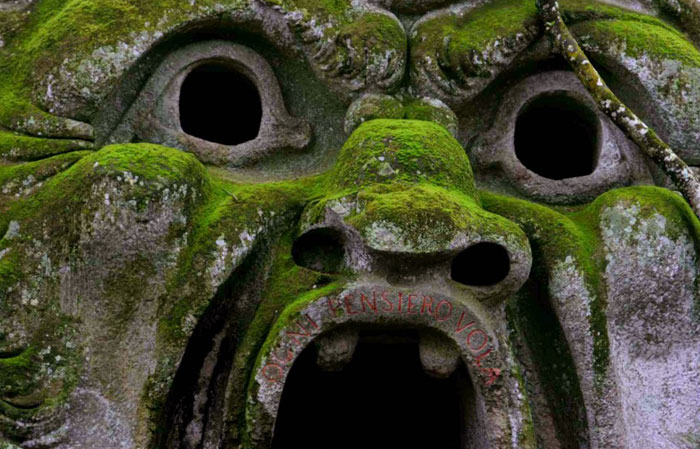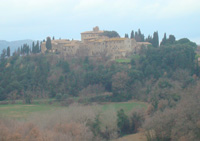| |
|
The gardens were created during the 16th century.[1] They are composed of a wooded park, located at the bottom of a valley where the castle of Orsini was erected, and populated by sculptures and small buildings divided among of the natural vegetation. The park is filed with bizarre and fascinating sculptures for which only
the accompanying inscriptions provide any explanation. Among the pieces
are a war elephant, a monstrous fish-head, a giant tearing another
giant in half, and a house built on a tilt to disorient the viewer.
Perhaps the most frightening piece in the garden is an enormous head,
mouth opened wide in a scream.
History
The park's name stems from the many larger-than-life sculptures, some sculpted in the bedrock, which populate this predominantly barren landscape. It is the work of Pier Francesco Orsini, called Vicino (1523–1585), a condottiero and patron of the arts, greatly devoted to his wife Giulia Farnese, not to confuse with her maternal grandmother Giulia Farnese, the mistress of Pope Alexander VI. When the wife of Orsini died, he created the gardens.
Monster must be understood in the Latin meaning of monstrare, which means to show and demonstrate. This then means that from stop to stop, from stage to stage, each element is a component of an immense, very neoplatonic poem to his lost love. Orsini always
insisted on the name sacred wood of Bomarzo. And he wrote: "Chiunque non sia colpito da questo parco non ammirerebbe neppure le sette meraviglie del mondo" ( Whoever is not astonished by this park would not even admire the seven wonders of the world.")
The design is attributed to Pirro Ligorio, and the sculptures to Simone Moschino.
The wealthy Orsini entrusted the original work to the Neapolitan artist and architect Pirro Ligorio, who completed some of the work of Saint Peter's Basilica in Rome after Michelangelo died.
The sculptures are attributed to Simone Moschino.
During the nineteenth century and deep into the twentieth the garden became overgrown and neglected, but in the 1970s a program of restoration was implemented by the Bettini family, and today the garden, which remains private property, is a major tourist attraction.
|
|
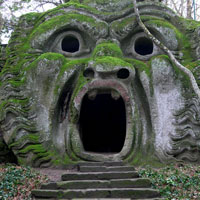 L'Orco classico L'Orco classico
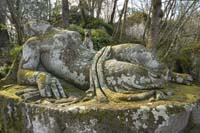
Il parco dei Mostri di Bomarzo
|
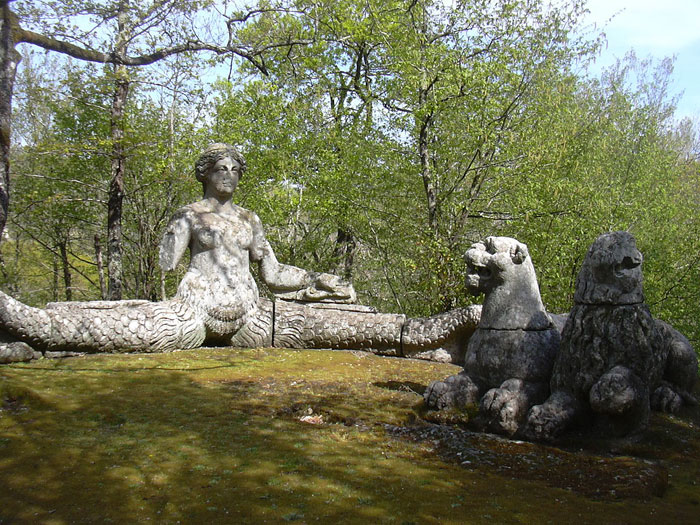 |
Sacro Bosco di Bomarzo - La sirena
|
Style
The park of Bomarzo was intended not to please, but to astonish, and like many Mannerist works of art, its symbolism is arcane : examples are a large sculpture of one of Hannibal's war elephants, which mangles a Roman legionary, or the statue of Ceres lounging on the bare ground, with a vase of verdure perched on her head.
The many monstrous statues appear to be unconnected to any rational plan and appear to have been strewn almost randomly about the area, sol per sfogare il Core ("just to set the heart free") as one inscription in the obelisks says.
Allusive verses in Italian by Annibal Caro (the first one is of him, in 1564), Bitussi and Cristoforo Madruzzo, some of them now eroded, were inscribed besides sculptures.
The reason for the layout and design of the garden is largely unknown : perhaps they were meant as a foil to the perfect symmetry and layout of the great Renaissance gardens nearby at Villa Farnese and Villa Lante. Next to a formal exedra is a tilting watchtowerlike casina, the so-called Casa Pendente ("Leaning House").
Sculptures
Pegasus, the winged horse
Two sirens, probably Proserpina, wife of Pluto
Orcus with its mouth wide open and on whose upper lip it is inscribed "All Thoughts Fly"
A whale
Two bears
A dragon attacked by lions
Proteus with weapons of Orsini
Hannibal's elephant catching a Roman legionary
Cerberus
A turtle with a winged woman on its back
A small theater of Nature
A giant who brutally shreds a character
A fountain called Pegasus
A triton in a niche
Two Ceres, sitting and standing
A sleeping nymph
Aphrodite
The giant fruit, cones and basins
Monuments
|
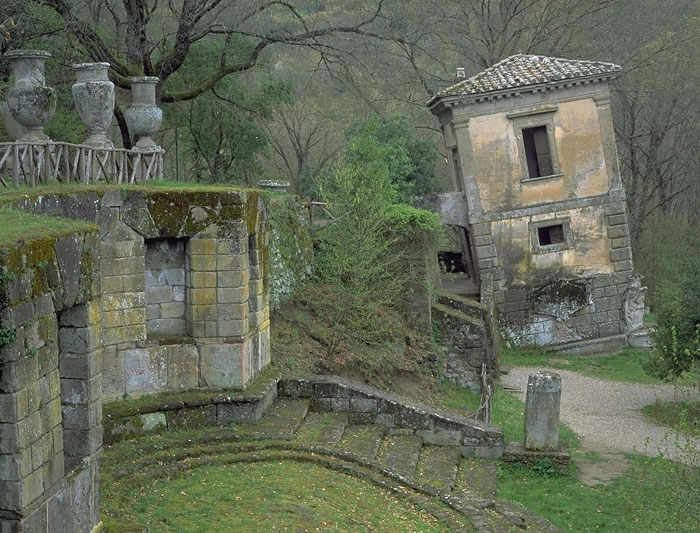 |
Casa pendente, the Leaning House
|
The Leaning House : dedicated to cardinal Cristoforo Madruzzo, who was a friend of Vicino Orsini and his wife. As cardinal, Bishop of Trent, and temporal ruler of that principality, Cristoforo Madruzzo naturally played a prominent part in the Council of Trent.
The Temple of Eternity : memorial to Giulia Farnese, located at the top of the garden, it is an octagonal building with a mixture of classical, Renaissance and Etruscan genres. It currently houses the tombs of Giovanni Bettini and Tina Severi, the owners who restored the garden in the twentieth century.
|
|
| |
Legacy
|
|
|
Built during the Italian Renaissance, the garden layout bore little resemblance to the symmetry of other Renaissance gardens, and the art was made in a rough "Mannerist" style, a sort of 16th-century version of Surrealism. One of the first artists to fall under its spell was the Dutch painter Bartholomeus Breenbergh, who in 1625 visited Bomarzo and made drawings of the monsters.
The surreal nature of the Parco dei Mostri appealed to Jean Cocteau and the great surrealist Salvador Dalí, who discussed it at great length. Salvador Dalí shot a short film there, and the sculptures inspired his 1946 painting The Temptation of Saint Anthony.
The poet André Pieyre de Mandiargues wrote an essay devoted to Bomarzo.
Niki de Saint Phalle was inspired by Bomarzo for her Tarot Garden, Giardino dei Tarocchi.
The story behind Bomarzo and the life of Pier Francesco Orsini are the subject of a novel by the Argentinian writer Manuel Mujica Láinez (1910–1984), Bomarzo (1962). Mujica Láinez himself wrote a libretto based on his novel, which was set to music by Alberto Ginastera (1967). The opera Bomarzo premièred in Washington in 1967, since the Argentine government had condemned it as sexually offensive.
The Dutch magic-surrealist painter Carel Willink used several of the park's statue groups in his paintings, e.g. The Eternal Cry and Balance of Forces.
A replica of the Orcus mouth appears as a major setpiece in the 1997 film The Relic.
|
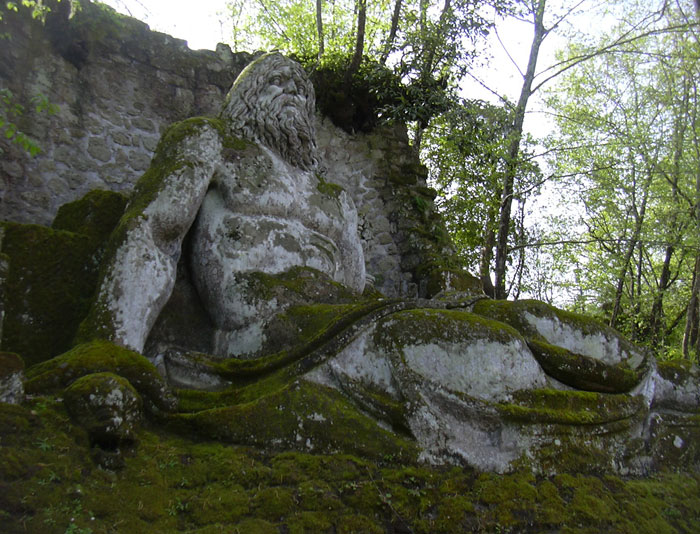 |
|
|
|
|
|
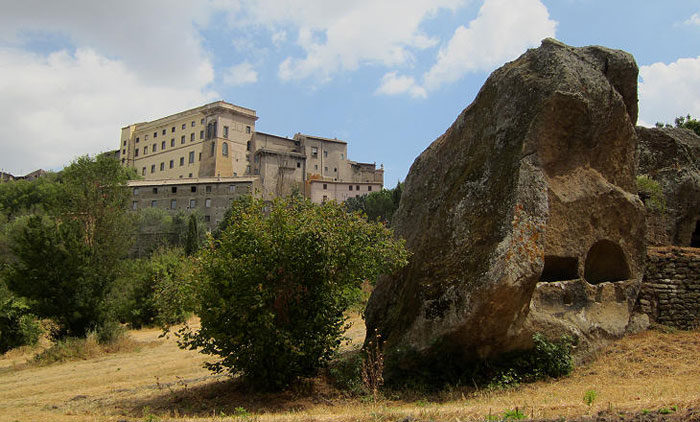 |
Palazzo Orsini
|
| |
|
|
|
|
| |
|

Parco dei Mostri | www.parcodeimostri.com
Bartholomeus Breenbergh, Castello Bomarzo, 1625, Rijksmuseum Amsterdam
Pictures of the Parceo dei Mostril | www.bergerfoundation.ch
Jacques-Édouard Berger (1945-1993), a leader of cultural trips to Europe, Egypt, United States and Near and Far East ( he had brought back over 100,000 pictures, for purposes of courses and lectures ( 'On Behalf of Art' ), was also a passionate collector of Art. After his death, the Fondation Jacques-Edouard Berger deposited his very important collections with the City of Lausanne (Switzerland) with a view to their installation in the Musée de design et d'arts appliqués contemporains (mudac).
YouTube | Michelangelo Antonioni. La villa dei mostri. 1950

[1] Bomarzo and the Orsini palace seen from the valley where the Sacred Wood is situated (in the foreground a boulder with ancient tombs). After the death of Pope Paul III Vicino Orsini fought at the side of the Farnese Dukes of Castro who supported France against Spain. He was taken prisoner for two years (1553-55). He was then involved by Pope Paul IV in a war against Spain which ended in total disaster. After this event he decided to retire to Bomarzo and to dedicate himself to the construction of a Sacred Wood which would represent his view of life.
At the time Vicino Orsini decided to build his Sacred Wood other gardens were in the process of being designed or completed at Caprarola, Bagnaia and Tivoli. They were all designed along the slope of a hill and had a very symmetrical structure. Vicino Orsini chose instead a hidden valley, rather far from his palace, probably because big boulders of peperino, a volcanic rock easy to cut, were available there.
[ Source: Rome in the footsteps of a 1750 traveller | www.romeartlover.it ]
[2] Pier Francesco Orsini (July 4, 1523 – 1583), also called Vicino Orsini, was an Italian condottiero and patron of the arts. He is famous as the commissioner of the Manieristic Park of the Monsters in Bomarzo (northern Lazio).
Born in Corigliano Calabro, he was the son of Giovanni Corrado Orsini and Clarice Anguillara.
He inherited the duchy of Bomarzo seven years after the death of the father, thank to intercession of cardinal Alessandro Farnese (the future Pope Paul III). He later married Alessandro's relative Giulia Farnese.
His career as condottiero ended in the 1550s, when he was taken prisoner and the Treaty of Cateau-Cambresis ended the French-Spanish Wars in Italy. Orsini then retired to Bomarzo where he surrounded himself with literates and artists, and devoted to an Epicurean style of life, which negated any contact with religion. Here he had the family completed and, starting from 1547, the famous Park, whose enigmatic constructions and sculptures are one of the most suggestive example of late Renaissance art in Italy.
After the death of his wife he dedicated the park to her memory.
Pier Francesco Orsini died in 1583.
|

Tuscany is one of the most popular tourist destinations in the world. Known for its enchanting landscapes, its fantastic and genuine food and unspoilt beautiful beaches. Located on the outskirts of Castiglioncello Bandini, Podere Santa Pia is one of the best places to slow traveling in Tuscany. The views stretch all the way to the Mediterranean sea and the islands of Montecristo and Corsica.
Artist and writer's residency | Holiday houses in Tuscany | Podere Santa Pia
|
| |
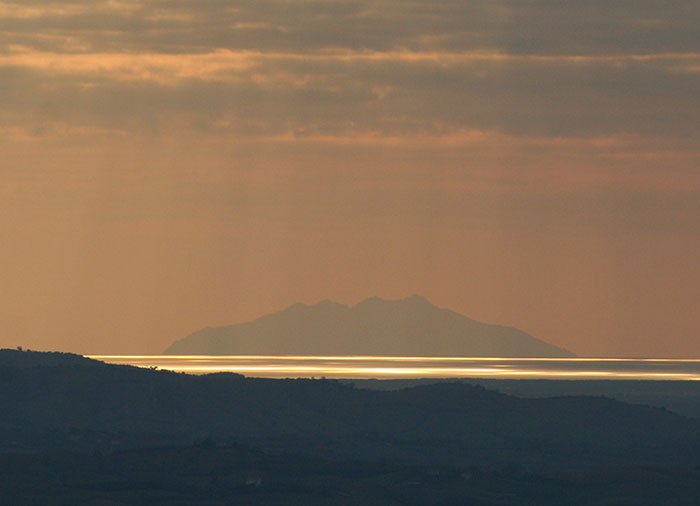 |
|
|
Montecristo Sunset, view from Podere Santa Pia |
| |
|
|
|
|
References
Bredekamp, Horst; Wolfram Janzer (1989). Vicino Orsini e il Sacro Bosco di Bomarzo. Un principe artista ed anarchico. Rome: Edizioni dell'Elefante.
Encarta Encyclopedia Encarta.msn.com Retrieved 27 June 2009 (French)
Publication on Bomarzo site (Italian)
Publication on Bomarzo site - Images
(Italian)
Hella Haase, Les jardins de Bomarzo, Seuil, Paris 2000 (French)
Richtsfeld, Bruno J.: Der "Heilige Wald" von Bomarzo und sein "Höllenmaul". In: Metamorphosen. Arbeiten von Werner Engelmann und ethnographische Objekte im Vergleich. Herausgegeben von Werner Engelmann und Bruno J. Richtsfeld. München 1989, S. 18 - 36.
(French)
Jessie Sheeler, Le Jardin de Bomarzo - Une énigme de la Renaissance, Actes Sud, Arles 2007
Calvesi M., Gli incantesimi di Bomarzo. Il Sacro Bosco tra arte e letteratura, Milano, Bompiani, 2000
M. Praz, I mostri di Bomarzo, in: Il Tempo, 3 (17-11-1949), en in: l'Illustrazione italiana, nr.8(1953), pp. 48-51, 86.
M. Praz, Panopticon Romano, Verona, 1967, pp. 107-113.
M. Praz: Il giardino dei sensi, Milaan, 1975, pp. 76-81.
A guide to villas and gardens in Italy (samengesteld door A. Aldrich en J. Walker voor de American Academy in Rome), Florence, 1938; voor Bomarzo: p.29.
G. Borghese, The horrors of Bomarzo, Harper's Magazine, 228 (1964), pp. 66-71.
G.H. Brassai, The mammoth figures of Bomarzo, Harper's Bazaar, (januari) 1953, pp. 70-73.
This article incorporates material from the Wikipedia articles Park of the Monsters and Pier Francesco Orsini, published under the GNU Free Documentation License.This article incorporates information from the revision as of 2009-06-27 of the equivalent article on the French Wikipedia. Wikimedia Commons has media related to: Parco dei Mostri (Bomarzo)

|
Viterbo is an ideal starting point for sightseeing tours and excursions following archaeological and historical itineraries such as those that wind along the route of the Via Francigena (Francigena Way), over the centuries taken by pilgrims who from the north would head for Rome. From Proceno to Acquapendente, from Bolsena to Montefiascone and then, again, past the Cimini mountains, the trail would continue to Vetralla, Capranica, Sutri and Monterosi.
In the province are also worth a mention the village of Bagnaia and the famous Villa Lante, a wonderful example of late Renaissance residence with an Italian garden, whose design is attributed to Jacopo Barozzi da Vignola as well as that of the Palazzo Farnese in Caprarola, another example of Renaissance pentagonal residence.
Well worth a visit also the parco dei Mostri (park of Monsters) of Bomarzo, a large park with gardens, buildings and fantastic sculptures, and the ancient village of Montecalvello, which rises around a castle where the famous Balthus, a contemporary painter, lived for thirty years.
|
|
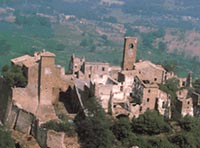
Celleno
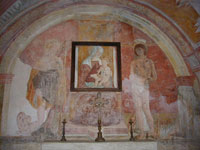
Montecalvello
|
Celleno, antico borgo medioevale, si trova all'incrocio di tre regioni: Lazio, Umbria e Toscana.
Il Convento, complesso del 1610, è situato all'ingresso dell'abitato di Celleno Vecchio.
|
|
| |
|
Villa Lante at Bagnaia is a Mannerist garden of surprise near Viterbo, attributed to Jacopo Barozzi da Vignola.
Since the 13th century, Bagnaia had been the personal fief of the bishops of Viterbo. The Villa Lante was thus not created by lay princes such as Orsini or Gonzagues, but by men of the Church.
The Villa Lante is the work of two bishops of Viterbo who succeeded each other on the city's episcopal throne.
The first was Gian Francesco Gambarra, the second, Alessandro Montalto.
According to the chroniclers of the time, the former was learned but lived simply. The latter, a cardinal at the age of seventeen, was the nephew of Pope Sixtus V.
The combination of Gambarra, a mature man, and Montalto, an adolescent, would produce one of the strangest Italian villas and one of the strangest Italian parks.
To create this work, Gambarra called on one of the great architects of his era, Giacomo Barozzi, known as "Il Vignola". Il Vignola worked in close collaboration with an acclaimed specialist, Pirro Ligorio, to deliver yet again a sort of initiatory path with surprises and shocks. A hydraulics specialist had to be added, a man from Sienna called Thomaso Chiruchi. It was he who adjusted the waterworks to perfection.
It should be noted that after having been the episcopal see, the villa was sold to the Duke of Lante in the 17th century.
[Source: Fondation Jacques-Edouard Berger | www.bergerfoundation.ch]
Gardens in Italy | Villa Lante | Villa Farnese
|
|
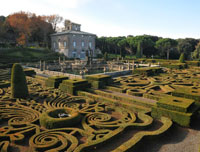
Villa Lante at Bagnaia |
|
|
|
|
|
Podere Santa Pia |
|
Podere Santa Pia, view from the garden
on the valley below
|
|
Castel Porrona, a charming medieval village dating back to the 11th century, between Cinigiano and Castiglioncello Bandini and Podere Santa Pia
|
YouTube | Michelangelo Antonioni. La villa dei mostri. 1950
|
|
|
|
|
|
